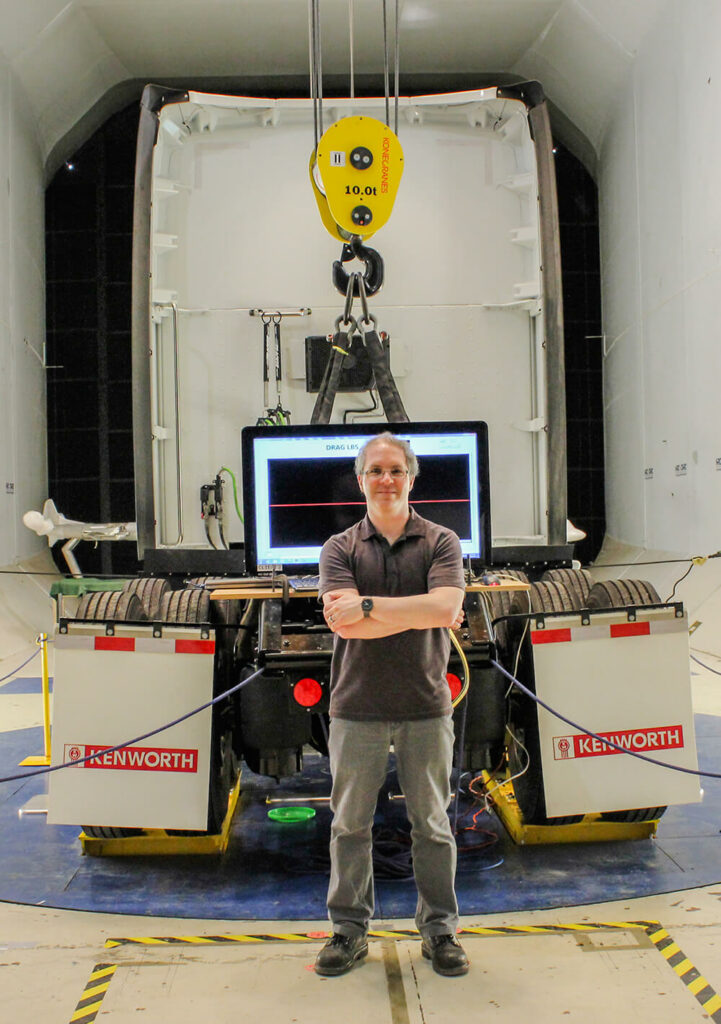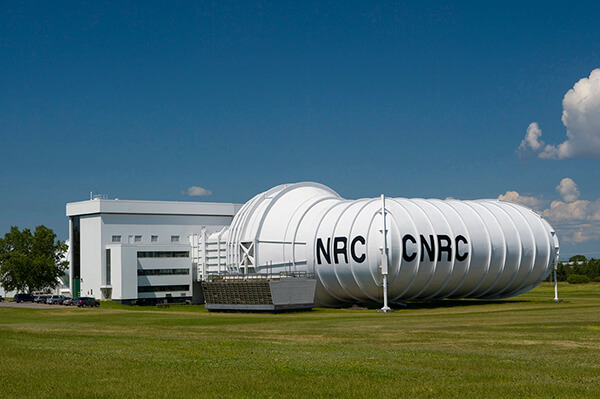Freight aerodynamics

Erin Brophy is the Manager of Communications at the Canadian Fuels Association.
For frequent flyers out of Ottawa Airport, it’s a routine landmark that eventually goes unnoticed. If you’re Brian McAuliffe, Adjunct Professor in Mechanical and Aerospace Engineering at Carleton University and Lead Aerodynamics Researcher at National Research Council of Canada—the giant white wind tunnel is a ‘playground’.
“I’m a bigger kid playing with bigger trucks” says McAuliffe as he walks toward the towering test area of the tunnel. “I started my career with an interest in aviation, never thinking that I’d end up working with trucks”.
‘Boxes on wheels’
McAuliffe’s research area is called Bluff-Body Aerodynamics. In other words, it’s research on surface vehicles that produce significant pressure drag and wakes—the opposite of airplanes. His specialty is testing the drag effects and fuel efficiency of freight trucks.
“The fact is that freight is going to remain ‘boxes on wheels’ pulled by diesel engines for a long time” says McAuliffe about the future of freight. Trailers, he explains, are a new addition to the proposed Canadian amendments to the Heavy-Duty Vehicle (HDV) and Engine Greenhouse Gas Emission Regulations beginning in 2018 and out to 2027.


left: Brian McAuliffe stands behind a freight aerodynamics demonstration at the National Research Council (NRC) Air Tunnel in Ottawa, ON. above: Outside of the NRC Wind Tunnel near the Ottawa International Airport.
This is where McAuliffe and the team at NRC step in.
“We provide HDV aerodynamic testing, data and analysis for both Environment and Climate Change Canada (ECCC) and for the US Environmental Protective Agency (EPA) to build policy; most recently, for the American Phase II GHG standards on HDVs as well as EPAs SmartWay verification testing” says McAuliffe.
The NRC’s clients are both government and private, domestic and international. This is no surprise given that the NRC’s wind tunnel is one of only three in the world of its size. “There aren’t a lot of places where you can drop in a full size cab and trailer to do testing, so we get an interesting mix of international clients” explains McAuliffe.
Proven and upcoming efficiencies
Not all fuel saving technology is what you would think of as ‘high tech’. “It’s amazing how simple adjustments to configuration can make a significant impact to fuel savings” he says, “even moving the cab and trailer one foot closer together can mean a difference of 1–2% in fuel efficiency—clients are surprised to learn this”.
Side panels and boat tails (also known as trailer tails) are components that can be added to existing trailers and can be seen on trucks today, he explains. “Individually, side panels and boat tails each provide about 5% in fuels savings when used alone. Interestingly, when used together—they provide 11%”.
Trailer specifications such as these are examples of what could be mandated designs for new trailer sales, as part of Canada’s HDV and Engine Greenhouse Gas Emission Regulations in 2018.
McAuliffe is also looking at ‘Fleet Platooning’, also known as electronic distancing between trucks. “Fleet platooning is essentially close-proximity driving between moving freight trucks on the road that allows for the greatest efficiency” explains McAuliffe. “What we’ve seen so far is that at a distance as far as 60 feet apart, there is greater than 5% increase in fuel efficiency, with up to 10% fuel savings at much shorter distances.”
These are promising developments. With diesel freight vehicles looking to pull their weight for the foreseeable future, it’s up to scientists like McAuliffe to test ways to improve fuel efficiency so that OEMs and freight companies can remain competitive, while at the same time meeting or exceeding environmental standards.
